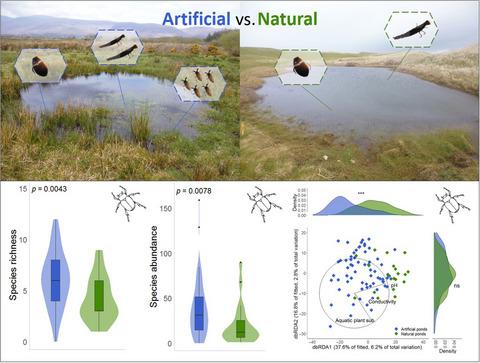当前位置:
X-MOL 学术
›
J. Appl. Ecol.
›
论文详情
Our official English website, www.x-mol.net, welcomes your feedback! (Note: you will need to create a separate account there.)
Artificial agri‐environment scheme ponds do not replicate natural environments despite higher aquatic and terrestrial invertebrate richness and abundance
Journal of Applied Ecology ( IF 5.7 ) Pub Date : 2020-09-13 , DOI: 10.1111/1365-2664.13738 Marina Reyne 1 , Myles Nolan 2 , Henry McGuiggan 1 , Aurélie Aubry 3 , Mark Emmerson 1, 4 , Ferdia Marnell 5 , Neil Reid 1, 4
中文翻译:

尽管水生和陆生无脊椎动物的丰富度和丰富度较高,人工农业环境计划池塘仍无法复制自然环境
更新日期:2020-09-13
Journal of Applied Ecology ( IF 5.7 ) Pub Date : 2020-09-13 , DOI: 10.1111/1365-2664.13738 Marina Reyne 1 , Myles Nolan 2 , Henry McGuiggan 1 , Aurélie Aubry 3 , Mark Emmerson 1, 4 , Ferdia Marnell 5 , Neil Reid 1, 4
Affiliation

|
- Farmland ponds are a highly threatened freshwater habitat which has undergone dramatic losses during the last 200 years due to land drainage schemes and agricultural intensification. Agri‐environment schemes (AES) incentivize farmers to adopt farming methods to benefit biodiversity, yet there are a paucity of data evaluating the success of artificially created AES ponds as analogues of natural ponds in an attempt to recreate lost environments.
- We examined variation in environmental parameters and aquatic and terrestrial invertebrate communities between 38 natural ponds and 91 artificial ponds that were created in south‐west Ireland (n = 129).
- Artificial ponds in agricultural grassland did not replicate natural ponds in adjacent semi‐natural habitats differing significantly in size, pH, conductivity, productivity (indicated by submerged and emergent plant cover including algae) and surrounding vegetation structure that is, sward height. These differences significantly influenced aquatic and terrestrial invertebrate community structure with a suite of indicator taxa in both natural and artificial ponds.
- The conservation value of artificial ponds in agricultural grasslands should not be underestimated as they had 43% higher aquatic species richness and 33% higher aquatic species abundance than natural ponds in adjacent semi‐natural habitats.
- Synthesis and applications. We demonstrate that artificial agri‐environment scheme ponds created in agricultural grasslands, whilst not direct analogues of natural ponds in adjacent semi‐natural habitats, do fulfil a role in preserving high local biodiversity albeit representing a different community of species. Creation of ponds in farmland as well as in adjacent natural habitats could provide a wider range of environmental conditions and richer associated macroinvertebrate communities, increasing landscape connectivity and further enhancing regional biodiversity.
中文翻译:

尽管水生和陆生无脊椎动物的丰富度和丰富度较高,人工农业环境计划池塘仍无法复制自然环境
- 农田池塘是一个受到高度威胁的淡水生境,由于土地排水计划和农业集约化,在过去的200年中,该池塘遭受了巨大损失。农业环境计划(AES)激励农民采用耕作方法来造福生物多样性,但是目前尚无足够的数据评估人工创建的AES池塘作为天然池塘类似物的成功性,以重现失落的环境。
- 我们研究了在西南爱尔兰创建的38个天然池塘和91个人工池塘之间的环境参数以及水生和陆生无脊椎动物群落的变化(n = 129)。
- 农业草原上的人工池塘没有在相邻的半自然生境中复制天然池塘,这些自然池塘的大小,pH,电导率,生产力(由包括藻类的淹没植物和出苗植物所指示)和周围的植被结构(草地高度)明显不同。这些差异极大地影响了天然和人工池塘的水生和陆生无脊椎动物群落结构,并带有一套指示性分类单元。
- 不应低估农业草地上人工池塘的保护价值,因为它们比邻近的半自然生境的天然池塘具有更高的43%的水生物种丰富度和33%的水生物种丰富度。
- 综合与应用。我们证明,在农业草原上创建的人工农业环境计划池塘虽然不是相邻半自然生境中自然池塘的直接类似物,但尽管代表了不同的物种群落,但在保护当地高生物多样性方面确实发挥了作用。在农田以及邻近的自然栖息地中建立池塘可提供更广泛的环境条件和更丰富的相关大型无脊椎动物群落,增加景观连通性并进一步增强区域生物多样性。



























 京公网安备 11010802027423号
京公网安备 11010802027423号